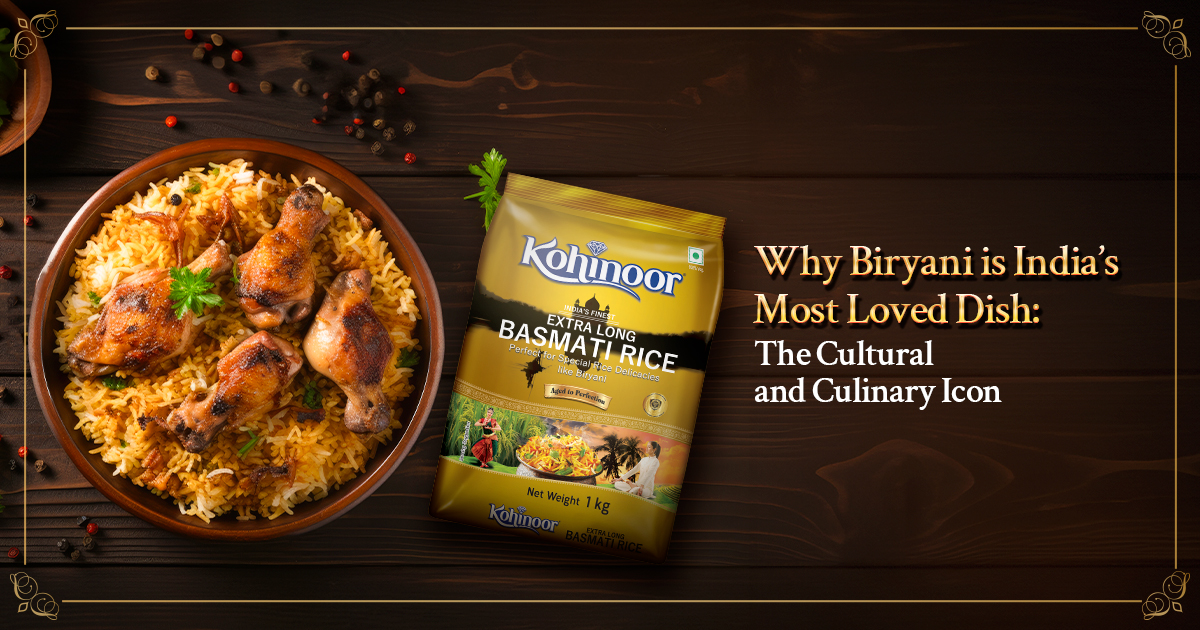Why Biryani is India’s Most Loved Dish The Cultural and Culinary Icon

30 May, 2025
Biryani isn't just food; it's an emotion, tradition, and identity layered with fragrant basmati rice and generations of memories. It's that one dish that sparks joy across India, cutting through differences of region, language, and belief. In this blog, we'll uncover the roots of biryani, explore its many regional avatars, from the royal Kolkata to the coastal Malabar biryani, and understand why it continues to win hearts across the country and beyond.
A Dish with Deep Roots
Biryani's origin can be traced back to Persian cuisine, where the word "birian" referred to frying before cooking. The dish was introduced to the Indian subcontinent by the Mughals, where it found royal flavour in the kitchens of emperors. But what began as a courtly delicacy quickly spread and adapted to the Indian palate.
In every Indian home today, there's a 'secret' biryani recipe guarded, perfected, and passed down. Whether it's a spicy chicken biryani or a simple veg biryani, each variant reflects a family's history. Over centuries, biryani has blended with local ingredients, spices, and techniques, evolving into a dish that carries both culinary weight and cultural meaning.
Regional Twists, One Love
Biryani may have one soul, but its body shifts from one state to another. Each region infuses the dish with cultural ingredients, making biryani a pan-Indian masterpiece.
- Hyderabadi Biryani is perhaps the most iconic. Made with marinated meat (often chicken or mutton), saffron, fried onions, and long-grain basmati rice, it's cooked using the dum method, where the pot is sealed and slow-cooked, allowing the flavours to meld in layers. It's rich, spicy, and has a royal legacy.
- Kolkata Biryani, on the other hand, is gentler on spices and unique for its inclusion of boiled potatoes. Influenced by Awadhi cuisine, it balances aroma and subtlety, often using fragrant Kohinoor Basmati Rice, rose water, and kewra.
- Lucknowi or Awadhi Biryani is known for its refined, mildly spiced flavours. It is usually prepared in a yakhni style, where the rice and meat are cooked separately before being layered. It's the epitome of balance and elegance.
- Malabar or Thalassery Biryani from Kerala uses short-grain rice and a mix of coastal spices, ghee, and sometimes coconut. It leans towards sweetness and richness and reflects Kerala's Arab trading influences.
- Even veg biryani, while contested by purists, has a devoted following. Rich in vegetables, paneer, and nuts, it follows the same layering, spicing, and dum cooking technique, making it just as indulgent and celebratory.
Biryani is More Than Just a Meal
Biryani is woven into the emotional fabric of India. It's served during weddings, Eid, family get-togethers, and even casual Sundays. It's that one dish that never fails to gather people around a shared table.
The moment the lid is lifted from the pot, a cloud of steam rises, carrying the warm fragrance of saffron, spices, and basmati rice. The room shifts. Conversations pause. Eyes follow the trail of aroma. Whether a giant pot of chicken biryani for a wedding or a small batch of veg biryani made on a weeknight, it is hunger-laced with joy.
It's a dish that commands attention and invites community. One biryani pot. Multiple hands. Shared smiles. That's what makes it unforgettable.
What Makes It So Irresistible?
Biryani's magic lies in its harmony. Every element of spice, rice, protein, and fat plays its part without overwhelming the other. The long grains of basmati rice, especially premium variants like Kohinoor Basmati Rice, soak in the flavours while holding their structure. Slow-cooked meat or vegetables release juices that seep into every grain. Ghee adds warmth and depth.
The taste is layered—literally and metaphorically. It delivers on aroma, mouthfeel, and complexity. From the crispy fried onions to the tender meat and buttery rice, biryani is a textbook in contrast and balance. It's not just cooked. It's composed.
Biryani is not just India's most loved dish. It's a living tradition. Each grain tells a story, and each variant reflects a region's soul. It connects hearts and homes, whether it's a spicy Hyderabadi biryani or a coconut-kissed Malabar version. The foundation of it all is quality rice, and Kohinoor Basmati Rice remains the gold standard for creating that perfect biryani experience. May your next feast be warm, shared, and unforgettable.
FAQ's
What is the origin of biryani in India?
Biryani came to India through Persian and Mughal influence. Initially a royal dish, it blended with Indian spices and techniques, evolving into regional forms nationwide and becoming a culinary staple.
What are the most popular types of biryani in India?
India's favourites include Hyderabadi biryani (spicy, layered), Kolkata biryani (aromatic, with potato), Lucknowi biryani (fragrant, slow-cooked), and Malabar biryani (coastal, coconut-flavoured). Each showcases local ingredients, traditions, and cooking methods.
Why is biryani so special to Indians?
Biryani symbolises celebration and togetherness. It appears at weddings, festivals, and family meals. Its sensory appeal to aroma, flavour, texture and the emotional weight it carries make it more than food: it's identity.
